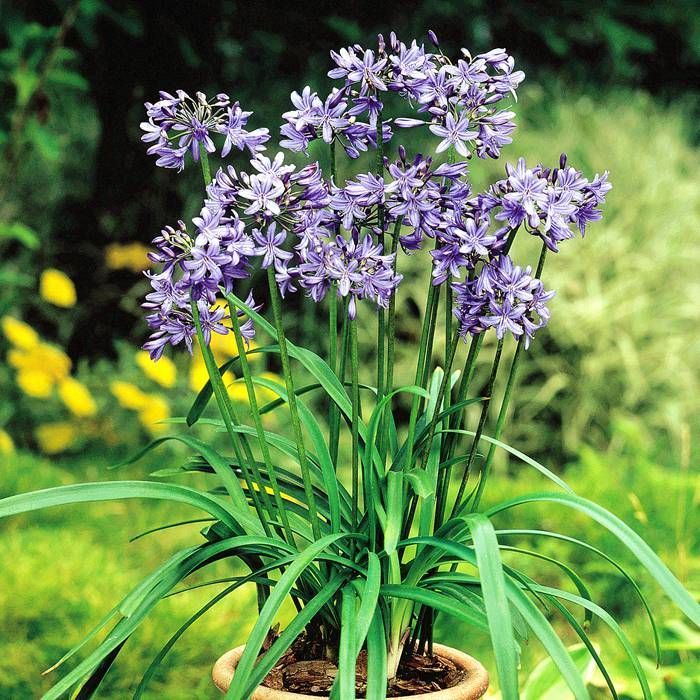How to Plant and Maintain Agapanthus in Your Garden
How to Plant and Maintain Agapanthus in Your Garden
Blog Article
Grasping the Art of Agapanthus Treatment: Necessary Steps for Healthy Development and Vivid Blooms
In the world of gardening, the cultivation of agapanthus stands as a rewarding venture for those who look for to support these elegant blooming plants. With their striking blooms and graceful foliage, agapanthus has actually captured the interest of gardeners worldwide. Nonetheless, attaining optimal development and dynamic blossoms needs a nuanced strategy that incorporates various essential steps. From selecting the best variety to grasping trimming techniques, the trip in the direction of growing thriving agapanthus plants is complex and holds the vital to unlocking the complete potential of these herb treasures.

Choosing the Right Agapanthus Range

When choosing the ideal Agapanthus variety for your garden, consider variables such as environment viability, bloom shade, and development behavior. Furthermore, take into consideration the climate in your area to make certain the Agapanthus range you choose can thrive in your details problems. Understanding the growth habit of various Agapanthus selections is vital for proper placement within your garden.
Perfect Planting Problems
Thinking about the optimal environmental requirements is important for effective Agapanthus farming. Agapanthus plants are sensitive to cold temperature levels and should be secured from frost throughout winter season months.
To make sure healthy and balanced growth and lively flowers, plant Agapanthus bulbs at a deepness of about 2-4 inches and room them 8-12 inches apart. Mulching around the base of the plants assists retain moisture and suppresses weed development.
Watering and Fertilizing Tips
Maintaining appropriate wetness degrees and giving crucial nutrients are crucial components in the care regimen for Agapanthus plants. When it comes to watering Agapanthus, it is important to strike a balance. These plants choose consistently wet soil yet are prone to root rot if overwatered.
Feeding Agapanthus is crucial for advertising healthy development and prolific blossoms. Use a well balanced fertilizer, such as a 10-10-10 formula, in the very early spring as new development emerges. By adhering to these watering and fertilizing suggestions, you can guarantee your Agapanthus plants prosper and generate vibrant, lasting blossoms.
Trimming Strategies for Agapanthus
Pruning Agapanthus plants at the appropriate times and with correct techniques is crucial for preserving their wellness and advertising ideal growth and blooming. The optimal time to trim Agapanthus is in late wintertime or very early springtime prior to new development emerges. Beginning by removing any dead or yellowing leaves near the base of read the plant. Cut them as short as possible without damaging the emerging shoots.
For flowered stems, wait till the flowers have actually withered and afterwards trim them back to the base. This not only cleans up the plant's appearance yet also motivates the growth of brand-new flower buds. Deadheading invested flowers can also reroute the browse this site plant's energy right into creating more flowers as opposed to setting seeds. Nevertheless, if you want to accumulate seeds for proliferation, leave some blossoms to fully grown and dry on the plant.
Remember to utilize tidy, sharp tools to make precise cuts and reduce the risk of introducing diseases. Agapanthus. Regular trimming will help keep your Agapanthus looking cool and healthy while ensuring an abundant display screen of attractive flowers
Handling Typical Bugs and Conditions
After guaranteeing correct pruning strategies for Agapanthus, it is essential to deal with typical pests and illness that can influence the health and vitality of these plants. One common bug that affects Agapanthus is the Agapanthus gall midge.
In addition, Agapanthus plants can experience from origin rot if they are planted in improperly draining pipes soil. By being cautious and taking prompt action versus diseases and insects, you can assist your Agapanthus plants prosper and produce vivid blooms. Agapanthus.

Verdict
In final thought, grasping the art of agapanthus care involves choosing the right range, offering optimal reference growing problems, appropriate watering and fertilizing, proper pruning strategies, and attending to usual insects and conditions. By following these crucial steps, you can make certain healthy development and vivid blooms for your agapanthus plants. Remember to consistently keep track of and preserve your plants to advertise their general health and longevity.
To make sure healthy and balanced growth and lively blossoms, plant Agapanthus light bulbs at a depth of concerning 2-4 inches and space them 8-12 inches apart. By adhering to these watering and fertilizing tips, you can ensure your Agapanthus plants flourish and produce lively, lasting blossoms.
One usual parasite that affects Agapanthus is the Agapanthus gall midget. In addition, Agapanthus plants can suffer from origin rot if they are planted in inadequately draining pipes dirt. By adhering to these necessary actions, you can ensure healthy development and vibrant blooms for your agapanthus plants.
Report this page